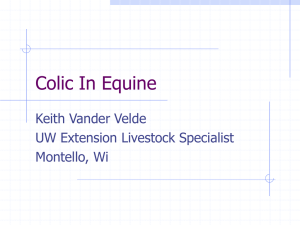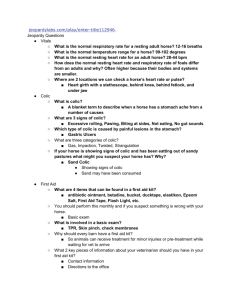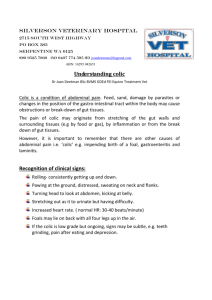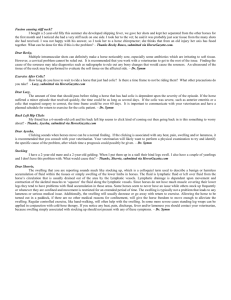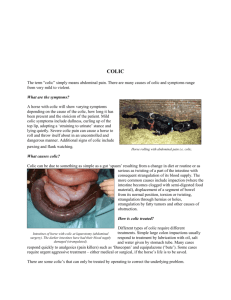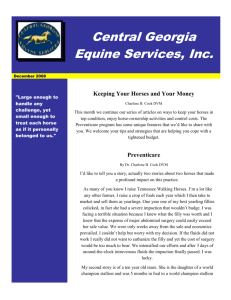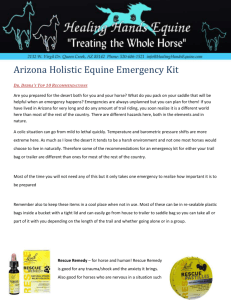C
advertisement
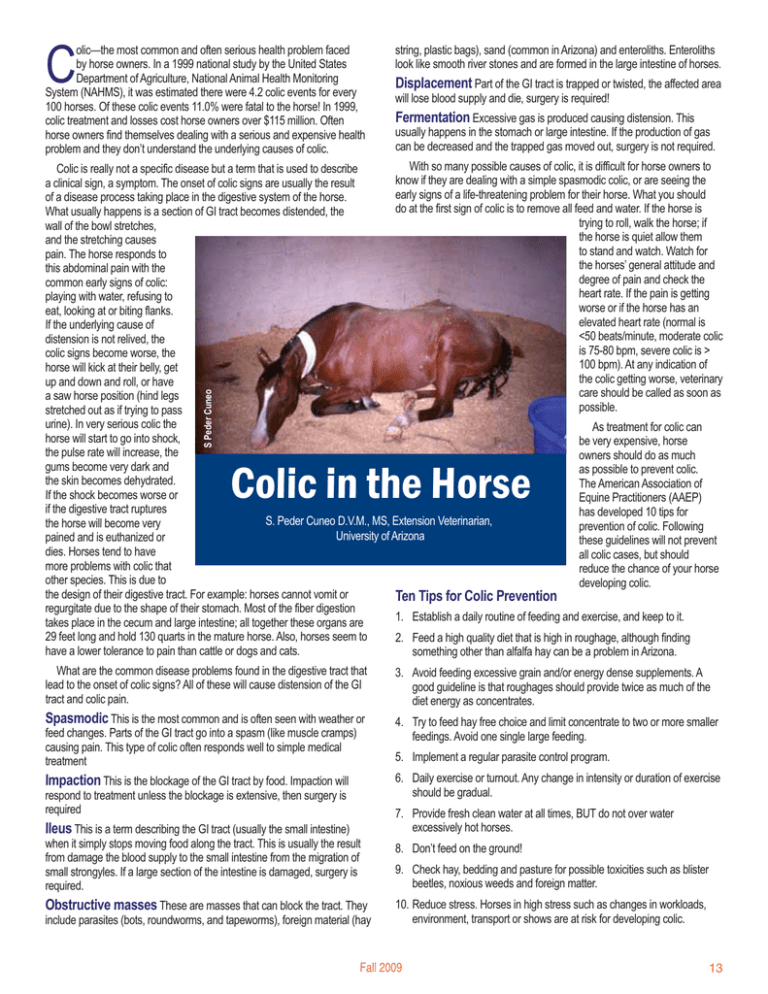
olic—the most common and often serious health problem faced by horse owners. In a 1999 national study by the United States Department of Agriculture, National Animal Health Monitoring System (NAHMS), it was estimated there were 4.2 colic events for every 100 horses. Of these colic events 11.0% were fatal to the horse! In 1999, colic treatment and losses cost horse owners over $115 million. Often horse owners find themselves dealing with a serious and expensive health problem and they don’t understand the underlying causes of colic. C string, plastic bags), sand (common in Arizona) and enteroliths. Enteroliths look like smooth river stones and are formed in the large intestine of horses. Displacement Part of the GI tract is trapped or twisted, the affected area will lose blood supply and die, surgery is required! Fermentation Excessive gas is produced causing distension. This usually happens in the stomach or large intestine. If the production of gas can be decreased and the trapped gas moved out, surgery is not required. S Peder Cuneo With so many possible causes of colic, it is difficult for horse owners to Colic is really not a specific disease but a term that is used to describe know if they are dealing with a simple spasmodic colic, or are seeing the a clinical sign, a symptom. The onset of colic signs are usually the result early signs of a life-threatening problem for their horse. What you should of a disease process taking place in the digestive system of the horse. do at the first sign of colic is to remove all feed and water. If the horse is What usually happens is a section of GI tract becomes distended, the trying to roll, walk the horse; if wall of the bowl stretches, the horse is quiet allow them and the stretching causes to stand and watch. Watch for pain. The horse responds to the horses’ general attitude and this abdominal pain with the degree of pain and check the common early signs of colic: heart rate. If the pain is getting playing with water, refusing to worse or if the horse has an eat, looking at or biting flanks. elevated heart rate (normal is If the underlying cause of <50 beats/minute, moderate colic distension is not relived, the is 75-80 bpm, severe colic is > colic signs become worse, the 100 bpm). At any indication of horse will kick at their belly, get the colic getting worse, veterinary up and down and roll, or have care should be called as soon as a saw horse position (hind legs possible. stretched out as if trying to pass urine). In very serious colic the As treatment for colic can horse will start to go into shock, be very expensive, horse the pulse rate will increase, the owners should do as much gums become very dark and as possible to prevent colic. the skin becomes dehydrated. The American Association of If the shock becomes worse or Equine Practitioners (AAEP) if the digestive tract ruptures has developed 10 tips for S. Peder Cuneo D.V.M., MS, Extension Veterinarian, the horse will become very prevention of colic. Following University of Arizona pained and is euthanized or these guidelines will not prevent dies. Horses tend to have all colic cases, but should more problems with colic that reduce the chance of your horse other species. This is due to developing colic. the design of their digestive tract. For example: horses cannot vomit or Ten Tips for Colic Prevention regurgitate due to the shape of their stomach. Most of the fiber digestion 1. Establish a daily routine of feeding and exercise, and keep to it. takes place in the cecum and large intestine; all together these organs are 29 feet long and hold 130 quarts in the mature horse. Also, horses seem to 2. Feed a high quality diet that is high in roughage, although finding have a lower tolerance to pain than cattle or dogs and cats. something other than alfalfa hay can be a problem in Arizona. What are the common disease problems found in the digestive tract that 3. Avoid feeding excessive grain and/or energy dense supplements. A lead to the onset of colic signs? All of these will cause distension of the GI good guideline is that roughages should provide twice as much of the tract and colic pain. diet energy as concentrates. Spasmodic This is the most common and is often seen with weather or 4. Try to feed hay free choice and limit concentrate to two or more smaller feed changes. Parts of the GI tract go into a spasm (like muscle cramps) feedings. Avoid one single large feeding. causing pain. This type of colic often responds well to simple medical 5. Implement a regular parasite control program. treatment 6. Daily exercise or turnout. Any change in intensity or duration of exercise Impaction This is the blockage of the GI tract by food. Impaction will should be gradual. respond to treatment unless the blockage is extensive, then surgery is required 7. Provide fresh clean water at all times, BUT do not over water excessively hot horses. Ileus This is a term describing the GI tract (usually the small intestine) when it simply stops moving food along the tract. This is usually the result 8. Don’t feed on the ground! from damage the blood supply to the small intestine from the migration of 9. Check hay, bedding and pasture for possible toxicities such as blister small strongyles. If a large section of the intestine is damaged, surgery is beetles, noxious weeds and foreign matter. required. 10. Reduce stress. Horses in high stress such as changes in workloads, Obstructive masses These are masses that can block the tract. They environment, transport or shows are at risk for developing colic. include parasites (bots, roundworms, and tapeworms), foreign material (hay Colic in the Horse Fall 2009 13
